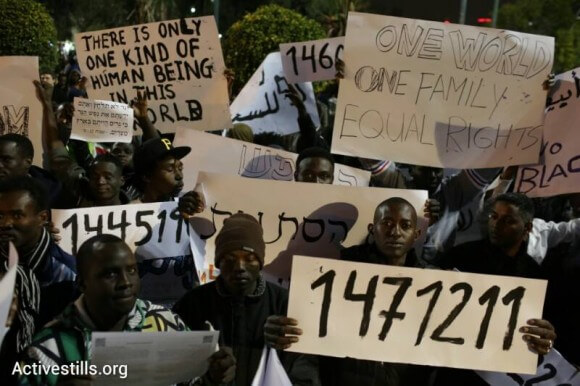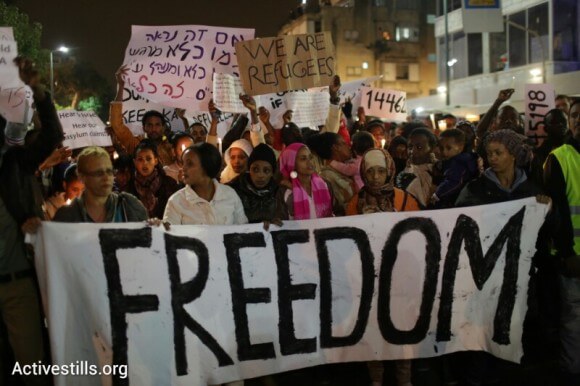
Thousands of African asylum-seekers, joined by Israeli supporters, held a silent march through Tel Aviv last night (Saturday). The protesters demand that the Israeli government recognize them as political refugees and request freedom for their countrymen, who are being held in three Negev desert detention centers, Saharonim, Ketziot and Holot, because of their official status as illegal immigrants. The march, which began at Lewinsky Park in southern Tel Aviv, concluded with a rally at Rabin Square. Ha’aretz estimated 5000 protesters participated in the demonstration.
An African man, who spoke in rudimentary Hebrew at the rally, compared the situation of the asylum-seekers to that of the Jews in Europe in 1939. He told those gathered about the dictatorial governments from which the immigrants had fled and their desire to live in a democracy and to have “equality.”
Many of the demonstrators carried candles, while others carried placards, some in Hebrew, and others in English and French. Many marched with signs on which were written the seven-digit identification number assigned them by the immigration authorities.
The idea for using the numbers on the placards came as a result of a newspaper article from earlier in the week which touched off a public outcry against the immigration authorities. The mass circulation daily, Ma’ariv, ran a story titled, “From the Point of View of the State, the Detainees Are Only Numbers.” That piece reported that African asylum-seekers who were arrested at a Jerusalem demonstration, after fleeing from the Holot “open” detention facility, were listed in a court document solely by their ID number [see graphic below]. The court papers were later refiled to include the names of the detainees.

For most Israeli Jews the numbers immediately bring to mind the ID numbers which were tattooed on the arms of Jews in the concentration camps of Europe during World War II. The numbers are instinctively associated with captivity and dehumanization in most Jewish minds.
A Hebrew language sign which was employed at the march on Saturday evening, one that had been carried at previous protests, was taken from the Book of Exodus (23, 9). The sign quotes the biblical injunction:
And a stranger shalt thou not oppress, for ye know the heart of a stranger, seeing ye were strangers in the land of Egypt.
This passage is recited each year by Jews during the Passover meal and for them it is one of the most familiar biblical quotations. Ironically, few Jews currently living in Israel have suffered oppression in Egypt, but many African asylum-seekers who are mostly Sudanese or Eritrean and crossed into Israel from Egypt did endure great hardship in the land of the pyramids (see “G.”‘s story, below).
Last week the left-leaning newspaper Ha’aretz published a sympathetic editorial calling for the government to review the asylum petitions of the Africans. More surprisingly, the right-wing paper Ma’ariv, in addition to the story quoted above, ran a very supportive editorial concerning the rights of the African refugees. Unfortunately however, most government officials and many Israelis hold extremely intolerant views toward the Sudanese and Eritrean immigrants.
The Israeli government currently employs a policy that includes neglect, vilification, detention and repatriation. It has been reported that Tel Aviv is presently trying to find an African nation to which the new immigrants could be transferred.
The plight of the Africans has been extensively covered by David Sheen. He made this video documenting a right-wing Israeli demonstration and “pogrom” against the Africans in which members of the Israeli Knesset participated. Sheen also has a new piece at the Electronic Intifada detailing the views of government officials and others whose racist attitudes toward the asylum-seekers are presently determining future Israeli policy.
There are about 60,000 non-Jewish Africans currently living illegally in Israel. Most live in southern Tel Aviv. The Israelis have recently completed a security fence on the southern border with Egypt that has stopped the African immigration. About 2,000 Africans are being held in detention facilities in the Negev desert.
An Eritrean man who participated in the Saturday demonstration and was identified only by his first name, Emmanuel, said that the situation is “not logical” because there are tens of thousands of illegal Africans living in Israel, but the government, “only wants to put 2000 in prison.” “How are you going to solve any problem by placing 2000 people in prison, he stated. “What will you do with the rest?” Emmanuel declared, “We are human beings and want to be related to as such. We did not come to do evil or to hurt anyone, only to get our lives back.”
———————————————–
The table below is from the Ma’ariv article, “From the Point of View of the State….” The header reads, “The People Behind the Numbers.” A translation of the table follows:

1451469
G., asylum-seeker from Eritrea
20 years old. He fled from Eritrea to Sudan, was kidnapped there by smugglers and brought to the Sinai where he was held prisoner. He suffered harsh torture by Bedouins. His family paid $25,000 in exchange for his release. During his imprisonment in the Sinai he witnessed men who were burned to death. He arrived in Israel in August, 2012. He has been imprisoned in Saharonim since that time.
1460267
M., asylum seeker from Darfur
In his 50s. He fled from the Jebel Marra district. In 2004, according to his testimony, “The war arrived in my village.” His eight-year-old son was murdered and his house was completely burned down twice. All his property was stolen. He moved with his children and wife to a refugee camp until he was able to flee to Egypt and from there to Israel. He arrived in Israel in December, 2012. Since then he has been held at Saharonim.
1445677
E., asylum-seeker from Darfur
23 years old. He was born and raised in Jebel Marra, from there he fled to the interior because of the war. He was accepted to study at the University of the Blue Nile [Sudan] and joined a student organization that supported the opposition. Many of his friends “were disappeared” or were murdered during that time. He infiltrated into Israel via the Sinai. He was caught upon entering Israel and imprisoned in Saharonim, where he remains to this day.
1447324
M., asylum-seeker from Darfur
23 years old. He fled from a town named Mogia [?] which during the war became a refugee camp. He joined the opposition forces and was place under constant surveillance by the government. He was arrested and was tortured severely. He said that among other things they threw boiling water on his arm. He arrived in Israel in July 2012. Since then he has been imprisoned in Saharonim.
———————————————————

Photo credit: Oren Ziv/Activestills.org


those aren’t the only weird numbers in israel, there are also the Graveyard of numbers https://mondoweiss.mystagingwebsite.com/2013/08/graveyard-of-numbers.html
RE: Emmanuel declared, “We are human beings and want to be related to as such. We did not come to do evil or to hurt anyone, only to get our lives back.”
A HYPOTHETICAL SUDANESE OR ERITREAN SPEAKS: Hath not a Sudanese or Eritrean eyes? Hath not a Sudanese or Eritrean hands, organs, dimensions, senses, affections, passions; fed with the same food, hurt with the same weapons, subject to the same diseases, heal’d by the same means, warm’d and cool’d by the same winter and summer as an Israeli Jew is? If you prick us, do we not bleed? If you tickle us, do we not laugh? If you poison us, do we not die? And if you wrong us, shall we not revenge?
If we are like you in the rest, we will resemble you in that.
If a Sudanese or Eritrean wrong an Israeli Jew, what is his humility?
Revenge. If an Israeli Jew wrong a Sudanese or Eritrean, what should his sufferance be by Jewish example? Why, revenge.
The villainy you teach me, I will execute, and it shall go hard but I will better the instruction.
The Merchant of Venice – http://en.wikipedia.org/wiki/The_Merchant_of_Venice
Thanks, Ira.
While we are looking at the resonance of images, one should note that the biblical verse is set in Koren type. This distinctive type is familiar to Israelis from formal texts. In English language terms, Koren type not quite as grand as Gothic but is not for everyday use either. It was actually developed for the first Hebrew bible printed in Israel (“wiping away Jewish shame” at all the Christian=printed bibles as Ben Gurion put it). Curiously, the man who initiated the new print type was an American Reform rabbi Judah Magnes. Magnes moved to a Palestine as a Zionist. He objected vocally to Ben Gurion’s aggression and went back home to the States in 1948 over an ideological rift with Israel.
The Israeli government can claim they do the number thing, because it helps them in [easily] identifying whatever it is they want to identify.
The last time I heard someone speak about Israel as a “light unto the nations” was Naftali Bennett, unironically.